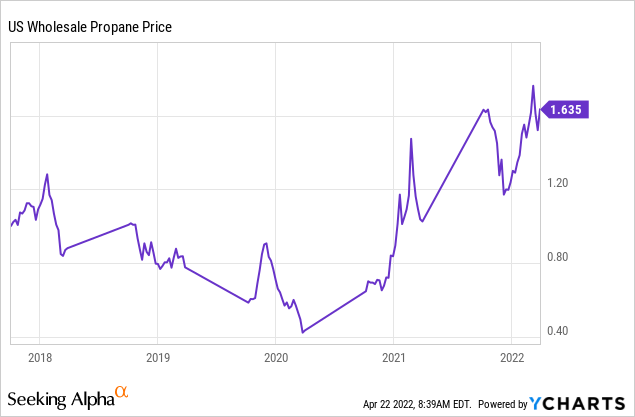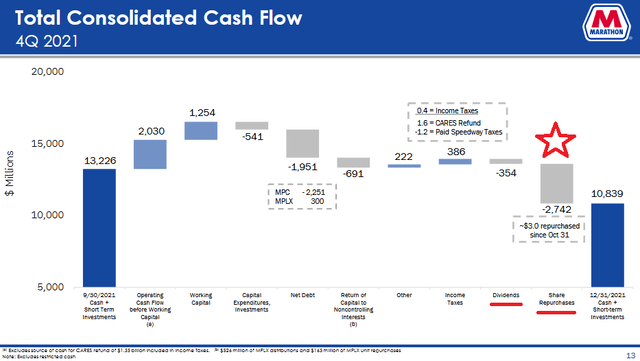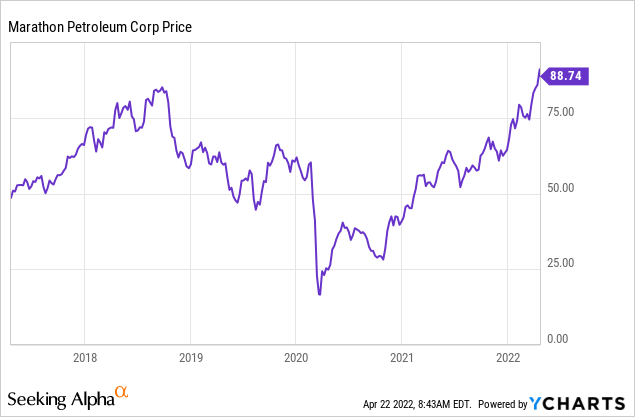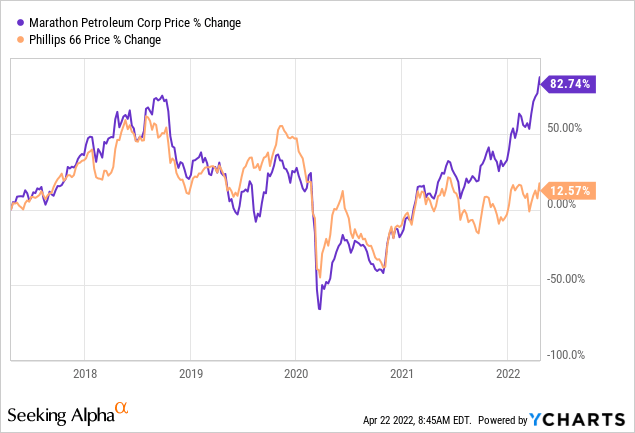
[ad_1]
WendellandCarolyn/iStock Editorial via Getty Images
As most of you know, the merger of Marathon Petroleum (NYSE:MPC) and Andeavor in 2018 created the largest US refiner with facilities on the Gulf Coast, the Mid-Continent, and the West Coast. Such a broad and geographically diverse footprint enables MPC to optimize feedstock and export refined products to the global market. Given the relatively low cost of domestic natural gas as compared to much of the rest of the world (and especially Europe), those exports are at a competitive advantage. Meantime, sanctions on Russian oil exports are pushing up the price of diesel in many parts of the world – another tailwind for MPC. However, despite the relatively bullish macro-environment, it would appear that MPC will continue to greatly over-emphasize share buybacks, as compared to dividends directly into the pockets of its ordinary shareholders.
Investment Thesis
The macro investment thesis for the refining companies is fairly straightforward. After a big drop in refined products due to the pandemic, the “opening-up” of the global economy due to widespread vaccination, Covid-19 treatments, and the general impression that the world is just going to have to learn to live with the virus, has led to a strong bounce-back in demand. Airline traffic has brought back jet-fuel demand, and there is strong demand for diesel in the trucking sector. Meantime, the summer driving season is likely to be huge as pent-up citizens have a strong desire to get out and enjoy life.
Indeed, the EIA weekly petroleum report for the week ending April 15th showed domestic refinery utilization was 91% – up from the low 70s during the pandemic. Gasoline inventories decreased by 0.8 million barrels last week and currently sit ~3% below the 5-year average for this time of year. Distillate fuel inventories were down by 2.7 million barrels last week and are ~20% below the 5-year average for this time of year while jet fuel supplied was up 15.7% over the same 4-week period of last year and almost all the major airlines recently reported strong demand going forward.
Meantime, relatively low feedstock costs in the US continue to favor US refiners. That is especially the case when it comes to producing diesel, since much of the sanctioned Russian oil is heavy crude that has a higher distillate split.
Earnings
For MPC specifically, Q4 refinery utilization was 94%, and the quarter was led by its Gulf Coast refineries – its largest regional capacity: USGC margin was up $648 million (+40%) as compared to Q3 (see the Q4 EPS report and slide 11 of the Q4 presentation). Other highlights include:
- Q4 net income of $774 million ($1.27 per diluted share).
- Returned ~$3 billion of capital through share buybacks since Oct 31; completed ~55% of $10 billion repurchase program through Jan 31; announced a new, incremental $5 billion repurchase authorization.
- Announced 2022 MPC standalone capital spending outlook of $1.7 billion; ~50% of growth capital for Martinez refinery conversion.
- The Martinez renewable fuels project is expected to have a total cost of $1.2 billion; ~$300 million has been spent to date, $700 million is projected for 2022, and $200 million for 2023.
Given the surge in natural gas prices in Europe as compared to the US, MPC can leverage its Gulf Coast production for the global export market. Indeed, on the Q4 conference call, Brian Partee, Senior VP of MPC’s Global Clean Products, said:
And then our export expansion as well. We’ve been really focused on our expansion of our export book. And specific to our export book, we’re really focused on more delivered cargoes. So we’re moving further down the value chain, higher margin capture. So we’ve had a lot of success in growing that line of our business.
Meantime, the Speedway deal is now in the rearview mirror, and the proceeds have – in addition to the big stock buyback plan – enabled MPC to reduce its net debt to capital ratio to 21%. That said, Speedway was a stable source of cash flow and leaves MPC much more dependent on refining & midstream.
Considering the large midstream business MPC has via its MPLX (MPLX) MLP, which pays quarterly distributions up to MPC, the relatively strong price of wholesale propane is another nice tailwind:

Shareholder Returns
As mentioned earlier, MPC is using the vast majority of the $21 billion in proceeds from the sale of Speedway for stock buybacks. As can be seen below, MPC is certainly “Buyback Heavy, Dividend Light”:

MPC
Note that in Q4 alone, the $2.742 billion MPC spent on share buybacks was a whopping 7.7x the $354 million the company allocated to the dividend. In my book, the ordinary shareholder is getting short-changed here. That is especially the case, in my opinion, considering that the company is arguably buying back shares during the up-cycle given the 5-year share price chart:

As a result, the current $2.32/share dividend yields only 2.6%. That compares to peer Phillips 66 (PSX), which pays a $3.68/share annual dividend and yields 4.3%. That said, note that shares of MPC have left PSX in the dust over the past 5-years:

However, I think that is more of a reason to be bullish on PSX at the present time than it is to be on MPC.
Summary & Conclusion
MPC’s stock has certainly benefited from the reopening theme, lower relative feedstock costs, and massive share buybacks: the stock has gained 66% over the past year. However, the ordinary shareholder is earning a low dividend while the company greatly over-emphasizes stock buybacks. At this point in the cycle, PSX looks like the better value. Not only is PSX’s dividend yield significantly higher (4.3% versus 2.6%), but PSX’s forward P/E of 10.6x compares very favorably to that of MPC (12.4x). Meantime, PSX is also significantly more diversified than is a Speedway-less MPC: it has a thriving marketing business and, with CPChem (its 50/50 JV with Chevron (CVX)), a world-class chemicals segment as well. Indeed, PSX is now much less dependent on refining than is MPC, with ~50% of normalized EBITDA now coming from its midstream & chemicals segments. That being the case, one would think PSX deserves the premium that the market is awarding to MPC. That being the case, I rate MPC a HOLD.
[ad_2]
Source link